The Corsair SP (Static Pressure), AF (High Airflow) 120/140mm Fan Review
by E. Fylladitakis on November 25, 2015 8:00 AM ESTCorsair's 120mm Performance
The AF120 Performance and AF120 Quiet Edition
First one up is the 'High Airflow' variant of the 120mm line (non-LED), which comes in Performance and Quiet modes. This is the Performance variant pressure/volume response at 12V and 7V:
Whereas the quiet model has this response - note the axes are the same for both AF120 models in this case.
While both AF120 fans in the graphs above share the same shape and design, with the only difference being their rotational speed, the performance curves are of similar shape but different magnitude. The performance of the AF120 fans is low when the impedance is very high but their volume flow capacity greatly increases when the airflow impedance falls below medium levels.
The SP120 Performance and Quiet Edition
As we move onto the Static Pressure line of fans, featuring fewer but wider fan blades (only 7 vs 11), the expectations lie in higher airflow in high-impedance (dense liquid cooler) scenarios. First up, the Performance model at 12V and 7V:
The Quiet model has reduced fan speeds, which gives a very different graph:
The performance of the SP120 is obviously much different than the AF120, as expected, but is also very different from the performance of the SP140 LED as well. The Performance Edition of the SP120 has an outrageous maximum speed of 2300 RPM and our instruments recorded an outstanding static pressure of 3.42 mmH2O at that speed. The curve declines sharply, with the SP120 displaying mediocre airflow gains as the airflow impedance decreases. It also has a significant stall area within the medium airflow impedance region.
The SP120 Perfomance and AF120 Performance Comparison
As the speed of the SP120 Performance Edition at 7 Volts and the maximum speed of the SP120 Quiet Edition coincide, it can be noticed that the two fans have an almost identical performance curve when operating at the same speed. This is natural as only the rotational speed of the fans differs, the design of the fan itself is identical. But when we compare the SP120 and AF120 variants to each other, we get the following (again, at 12V and 7V)
And in the Quiet versions (note, different axes):
The above two comparisons between the Performance and Quiet versions of the SP120 and AF120 respectively are somewhat unfair. From just a quick look at the graphs, it appears that the SP120 outperforms the AF120 under almost any conditions when both fans are operating at their maximum stock speeds. That however is not correct, as the SP120 versions have a much higher top speed are are in both cases louder. With both the AF120 and the SP120 running at the same speed (and similar noise profiles) we got the following performance curves.
With both fans running at the same speed, the advantages and disadvantages of each design become more apparent. The AF120 provides higher air volume flow in low airflow impedance setups while the SP120 can maintain higher air volume flow levels when the airflow impedance is high. Strangely, even though the SP120 is moving considerably less air while entirely unobstructed, it generates about the same level of noise as the AF120. We can only assume that the large blades of the SP120 generate a very turbulent air flow.


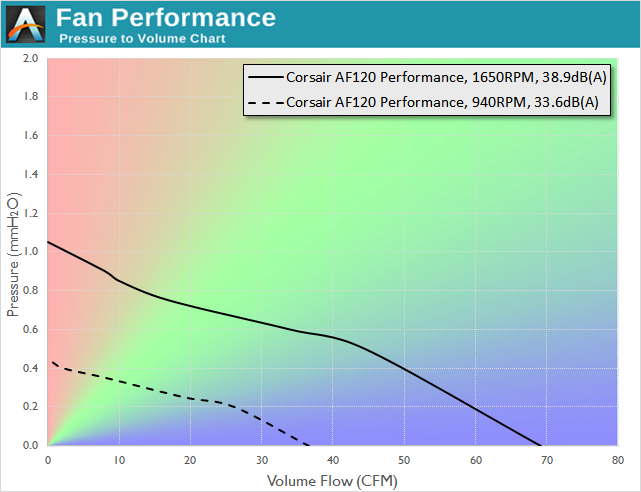
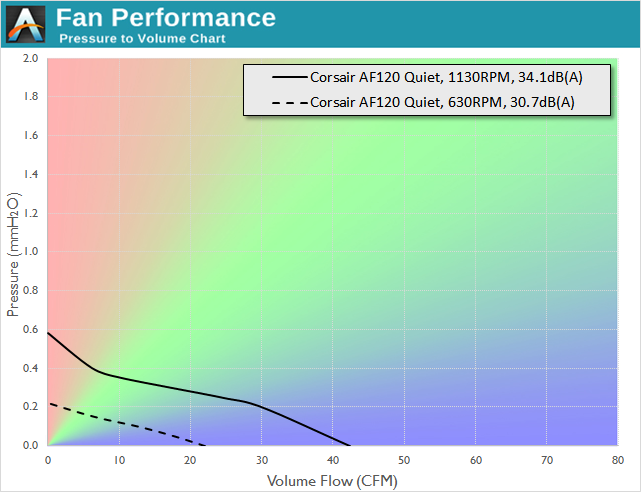
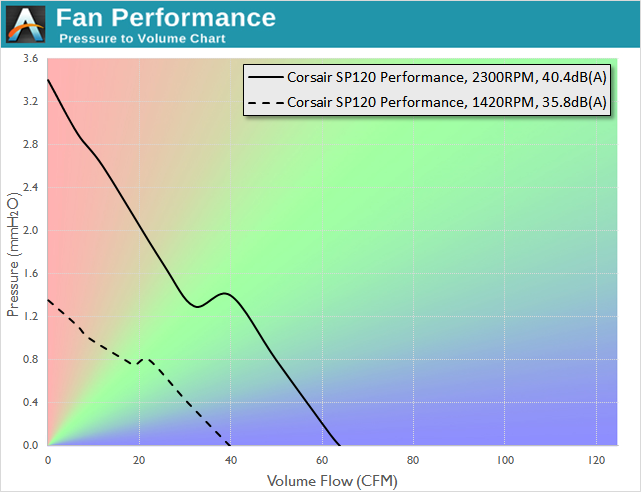
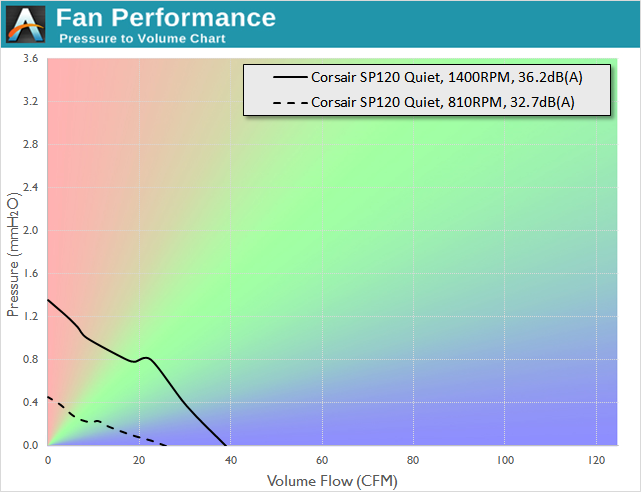

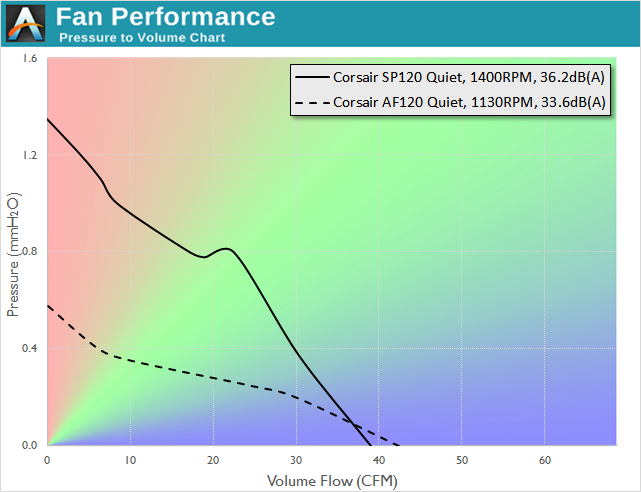
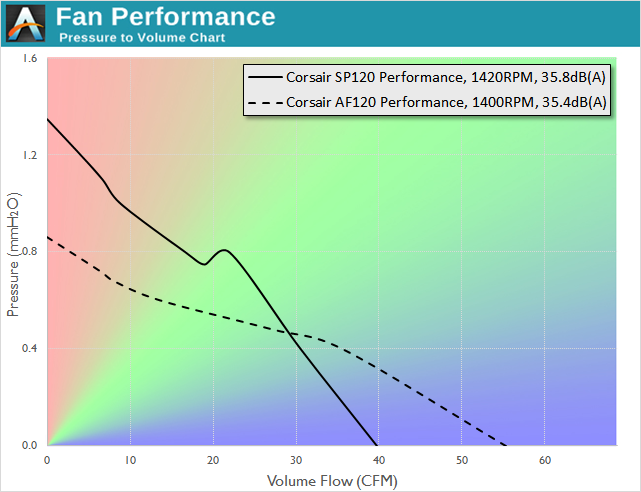








92 Comments
View All Comments
RdVi - Wednesday, November 25, 2015 - link
A nice introduction to a more in depth investigation of real world fan performance. I hope to see many more articles like this one with comparisons between brands where possible. Great work.Valantar - Thursday, November 26, 2015 - link
Agreed, this was an interesting and informative read. Looking forward to some comparisons, especially high-end brands like Noctua, to see what value you're actually getting from the extra outlay.maximumGPU - Wednesday, November 25, 2015 - link
Thank you for setting the record straight in regards to the LED models. At first look anyone could be fooled that these are the standard models with some led's strapped in.inighthawki - Wednesday, November 25, 2015 - link
With that in mind, is there a reason the LED versions are built differently? That is, the article mentions the difference in the fan blades, but I'm wondering why there is a difference.ninjaquick - Wednesday, November 25, 2015 - link
Ask Corsair.tipoo - Wednesday, November 25, 2015 - link
Just a misanthropic guess, but saving pennies to make up for the LED?TheKiwi - Thursday, November 26, 2015 - link
I actually asked (well, kinda angrily ranted) at a Corsair product manager on IRC about that once. Basically, people buying LED fans don't care about high-end performance as much. There's no market for high-end LED fans.I think it's dumb, but they probably have market research to back it up.
Barbarossa - Thursday, December 3, 2015 - link
Corsair George here - this is pretty close to right, or at least it was at the time of the product dev 2-3 years ago. When we started doing fans in 2012 we had no data that proved that "high cost" LED fans sold at all. Basically, if it had LEDs in it, nobody paid a premium. At the time the best fans were Noctua or Scythe, neither of which used LEDs.So when we decided to do performance LED fans, we focused on making them perform very well for their price. Note that the LED fans do not include the swappable color rings or the rubber corners or the hydraulic bearings - all cost saving measures because LED fans had to cost significantly less.
Nowadays, with a few more higher-cost LED options, we are somewhat rethinking that.
I think there's room for a truly high performance LED fan out there - if it doesn't look and feel cheap.
Also, it's been almost 4 years since we released the SP / AF performance fans - I think we're about due for something new.
Phreedom1 - Sunday, December 6, 2015 - link
Awesome explanation George. Hope Corsair does come out with a new fan product.rscsrAT - Wednesday, November 25, 2015 - link
It's nice to see a fan review again.But I think that the presentation is awful. You should add scale lines for the different cooler types instead of the color gradients. Then it would actually be useful.
And the word impedance should be limited to electrical resistance. I am studying mechanical engineering and I haven't heard impedance once (in fluid dynamics). It is usually refered as resistance (or drag for bodies in free flow).